A Most Unusual & Provocative Bonsai Extravaganza
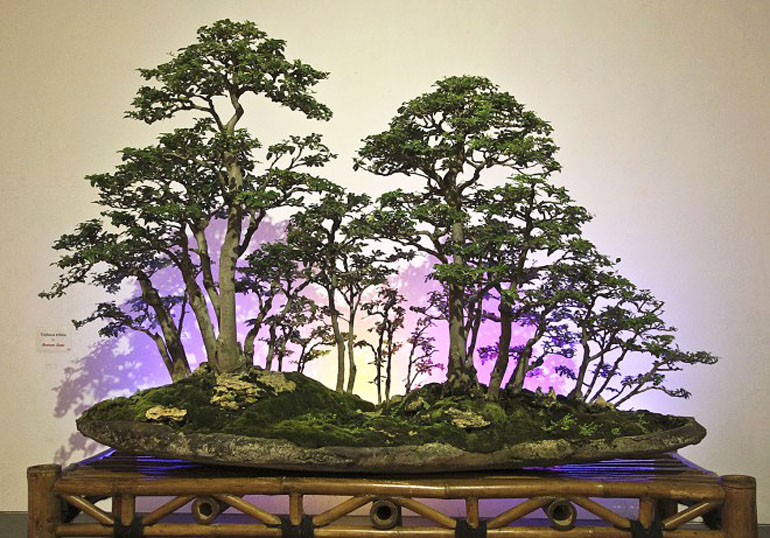
I don't know how big this planting is, though I'm leaning toward pretty big. Impressive too with its sophisticated sense of depth (larger trees in front and smaller toward the back). Not to overlook the very large pot with its flowing lines and no doubt hefty price tag. This photo and the next three below are from Bill Valavanis' blog
Continuing with yesterday’s mixed media bonsai theme, this one is from Robert Steven’s 2014 1st International Bonsai Biennale. At the time we referred to it as the most unusual and provocative bonsai extravaganza ever.
–
–

One of many display areas

One of a whole slew of impressive bonsai
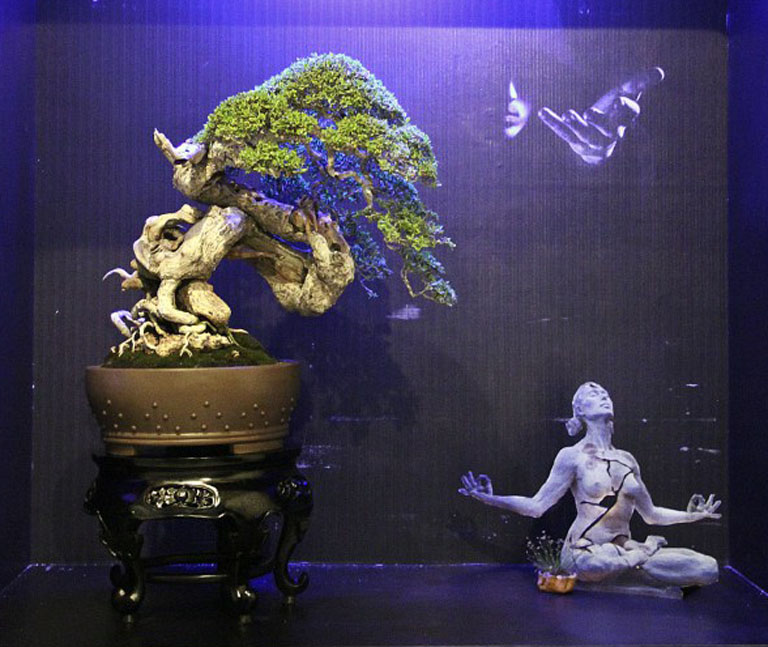
Another impressive bonsai as part of one of many unusual mixed media displays
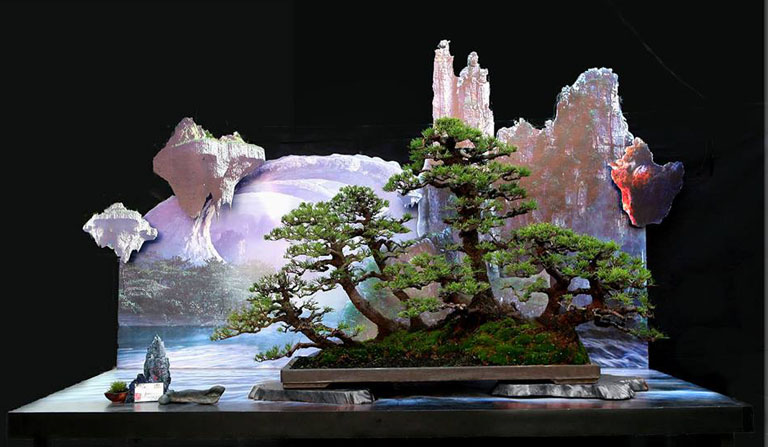
Another mixed media display. This one and the two below are from Robert's facebook photos
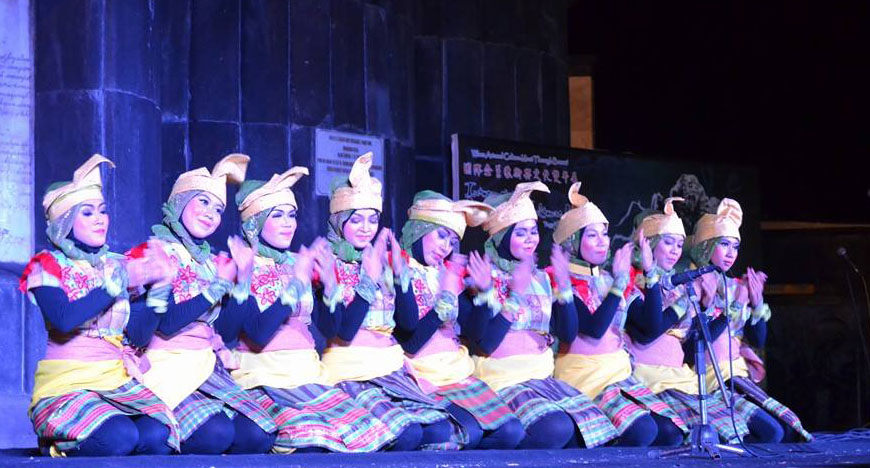
Some of the many opening ceremony performers
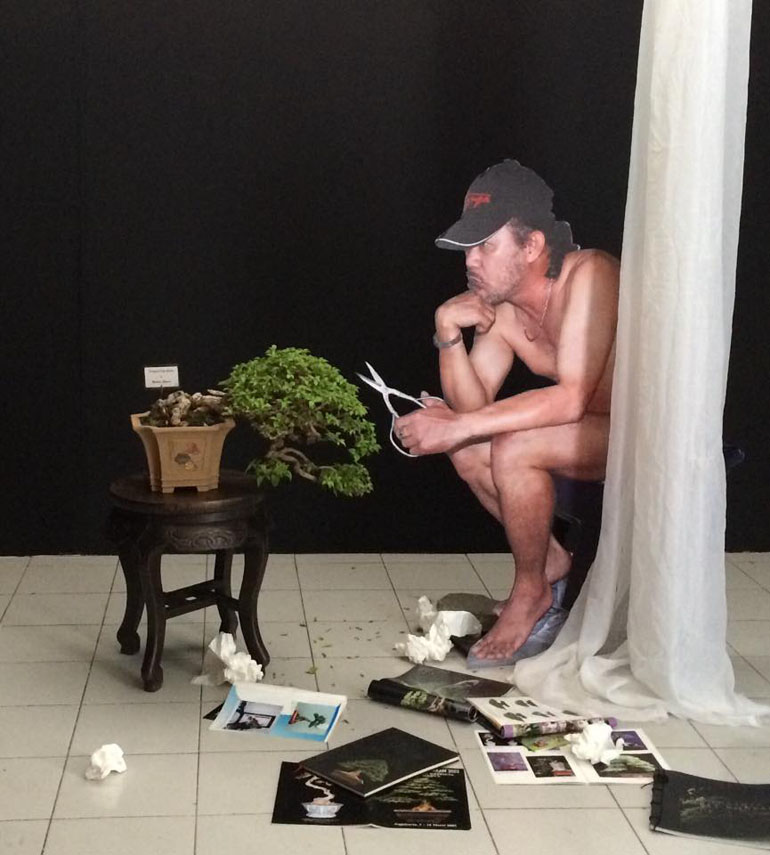
The Maestro himself
Bonsai Art & Ink Painting – A Perfect Intersection
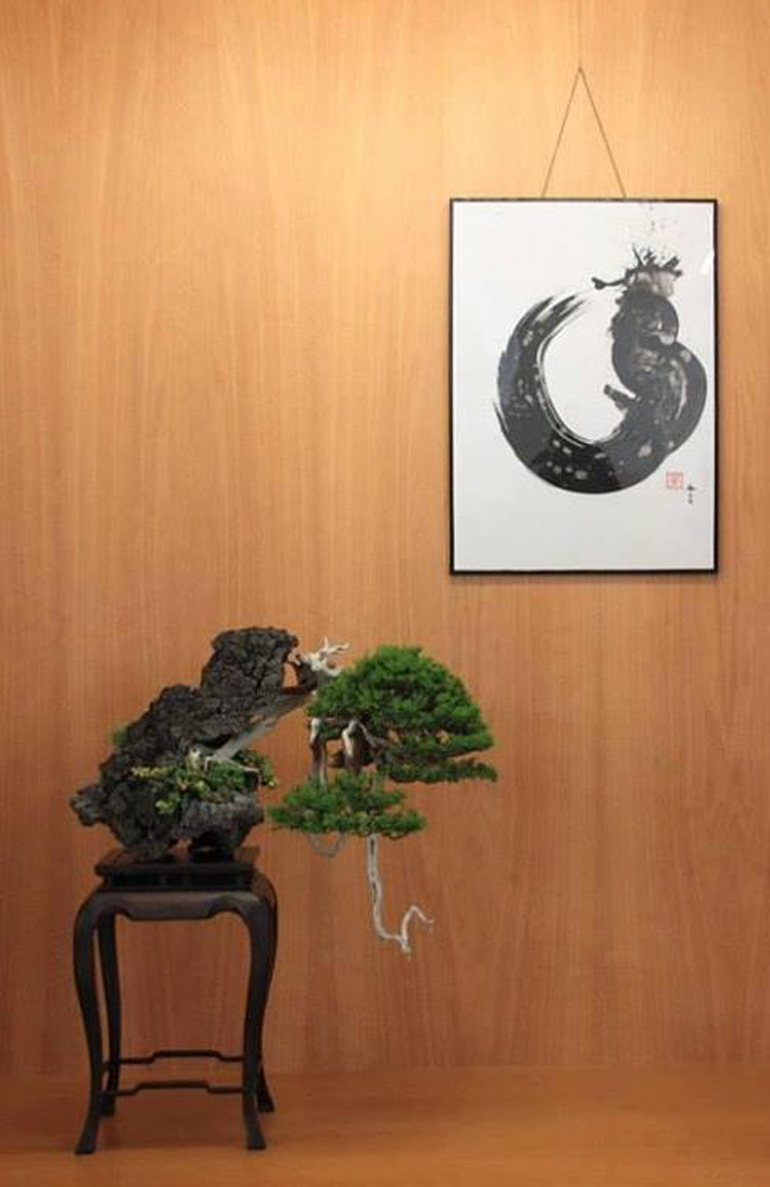
Something new under the sun! Sumi artist Sonia Stella's caption reads... "Bonsai by Sandro Segneri and modern ink by me"
I’m always a little stoked when we discover a new bonsai artist (quoted from our July 14th post). Now we can double down on that with today’s discovery of Sonia Stella’s Bonsai Art & Ink Painting – Sakura Studio. Or maybe triple down, with the added excitement of discovering a perfect intersection of two arts performed at such a high level.
–
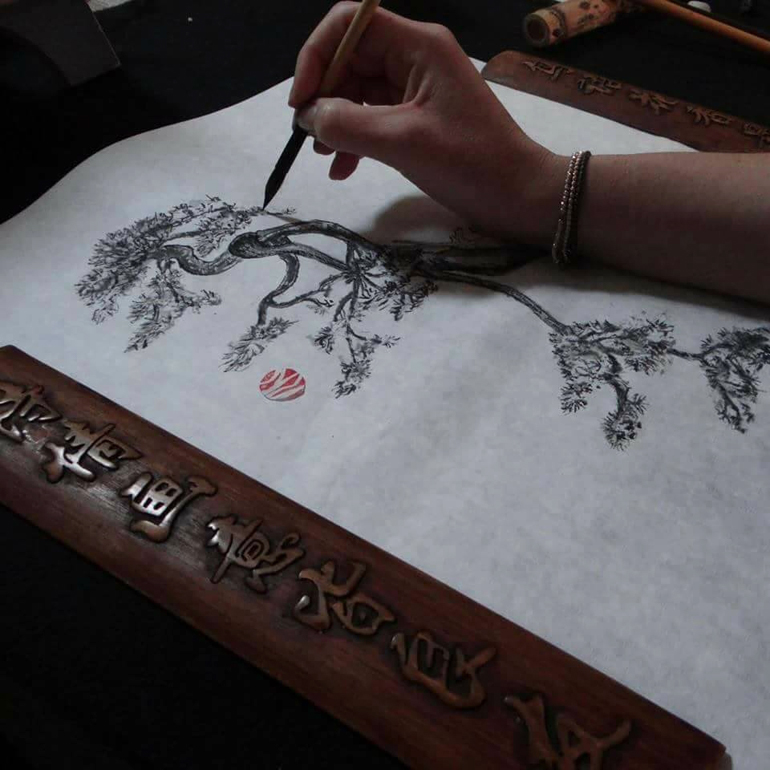
Exquisite, elegant, beautiful
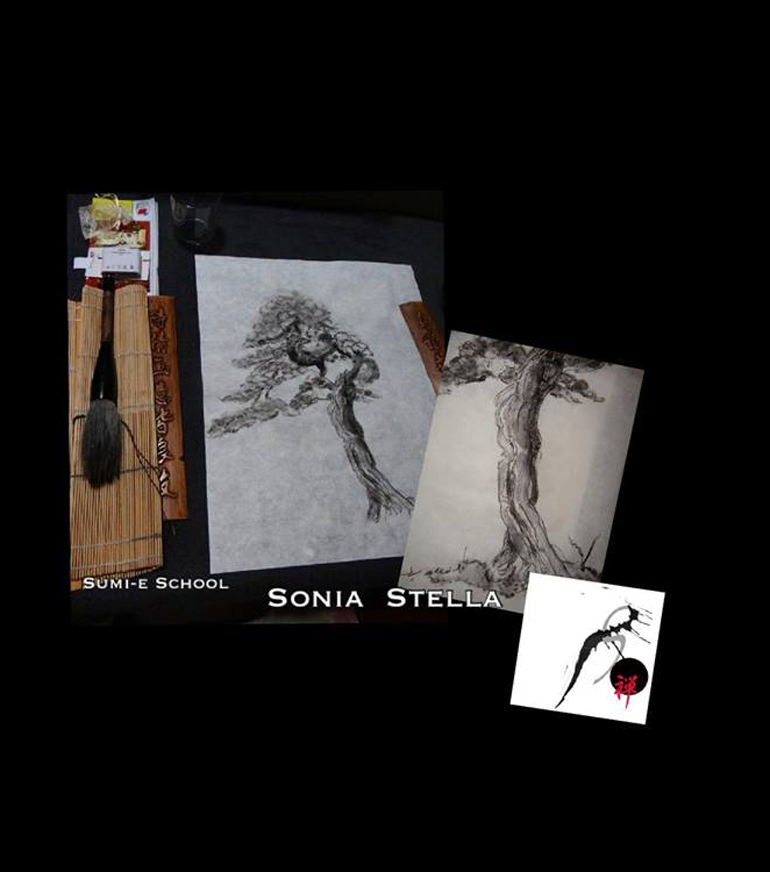
More evidence
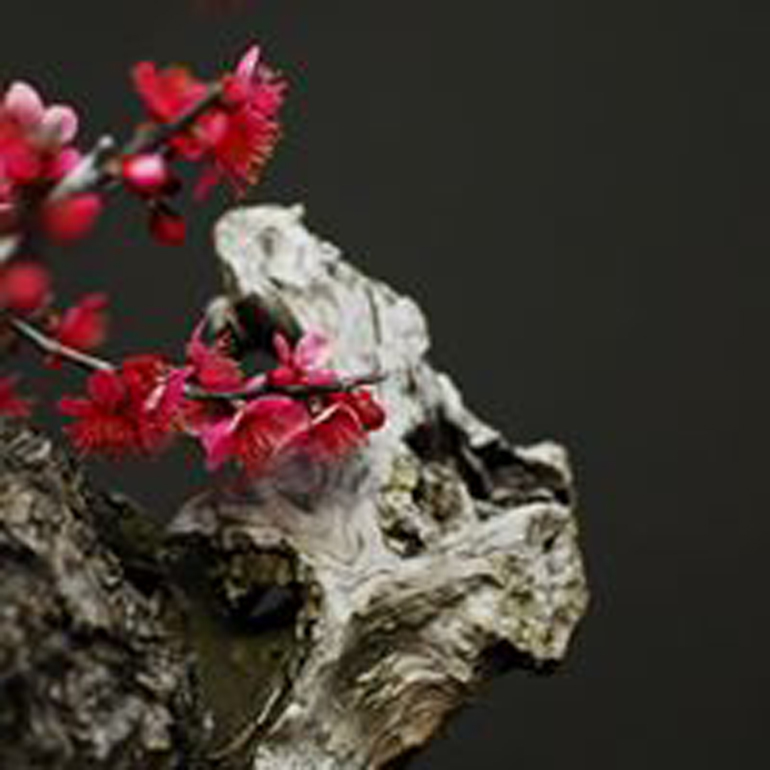
A piece of an Ume (Japanese flowering apricot). From Sonia's photo album titled Inspiration Bonsai. Stella's eye for bonsai is impressive. Just as you might expect
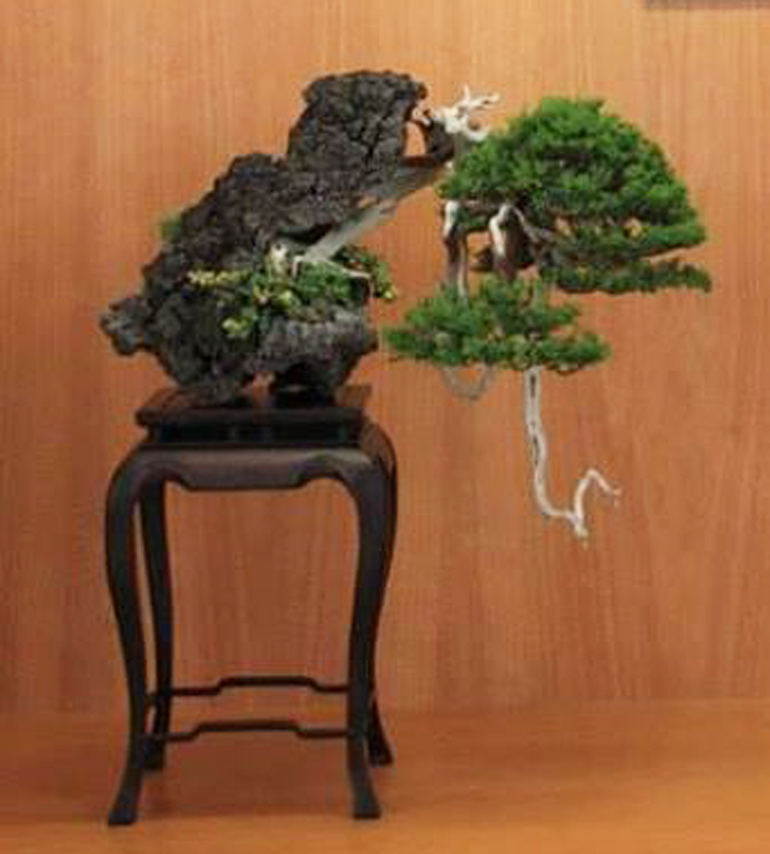
I cropped the lead photo in hopes of a better look at Sandro Segneri's magnificent root-on-rock bonsai. If I have a complaint about Sonia Stella's Bonsai Art & Ink Painting - Sakura Studio, it's that this is the only bonsai I could find among a whole series of shots, that is attributed to the artist.
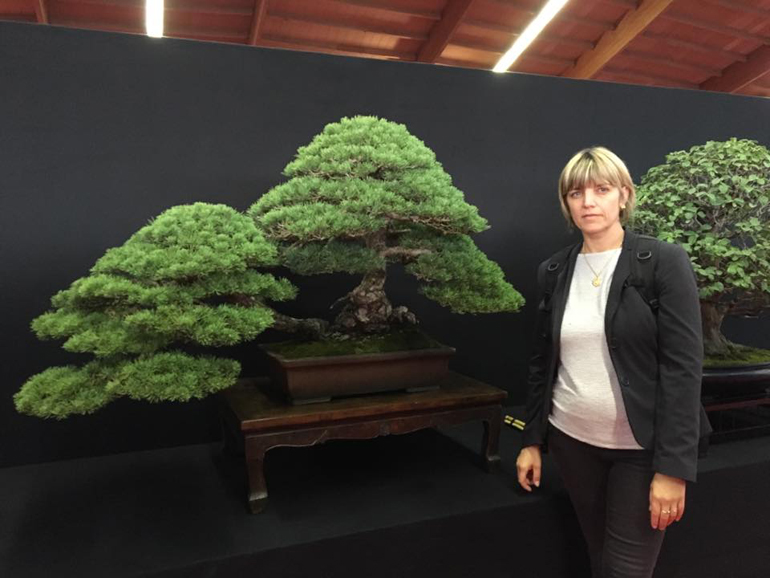
Sonia with an impressive, to say the least, Japanese white pine
Superior Bonsai Deserve a Superior Turntable
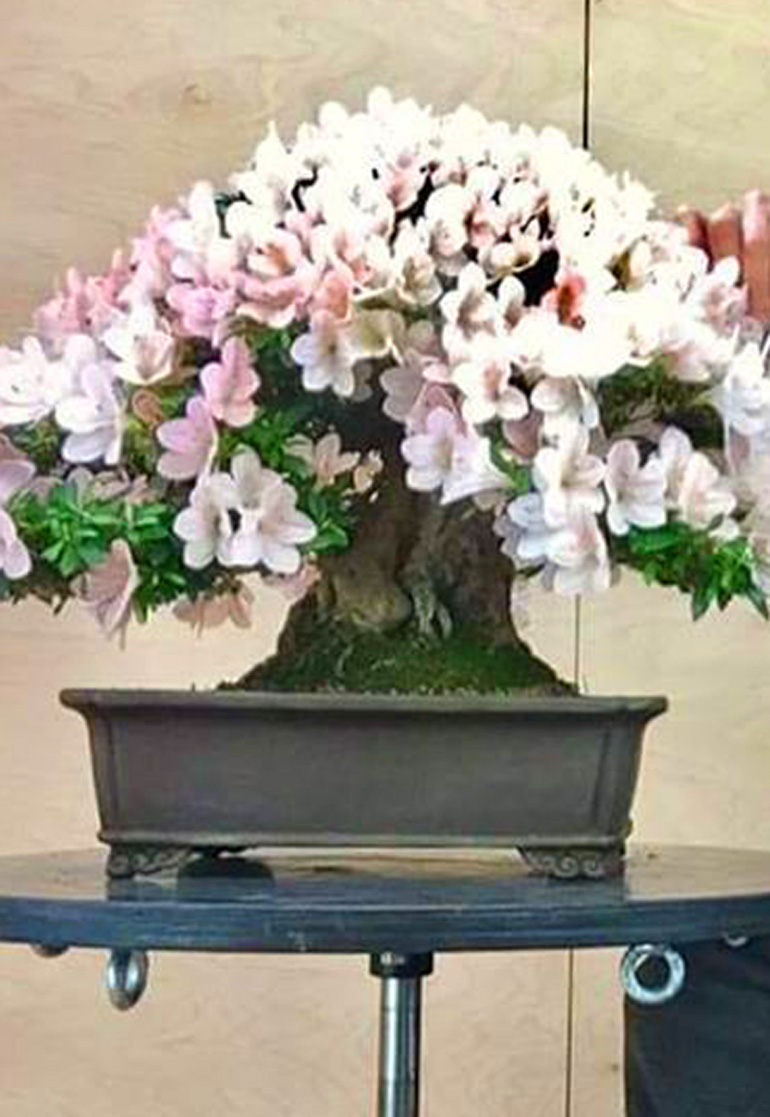
Everything looks good on a Green T turntable and this luscious azalea in full flower is no exception (it will look even better on with the new green rims - see below). Here's part of the caption that the folks at Green T wrote with this photo... "@bonsaiwarsaw loves azaleas! This variety of bonsai require lots of special care and dedication and we are glad that such a young innovative bonsai artist is trusting Green T to do his best!" I cropped the original photo to feature just the tree. The uncropped version is below.
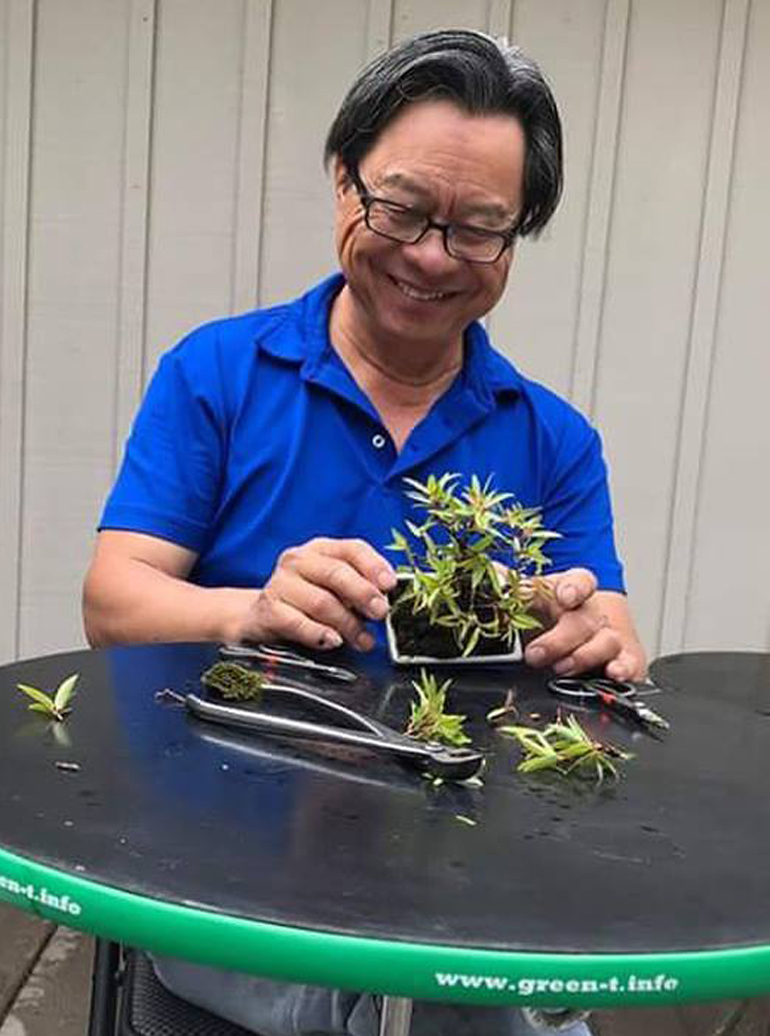
One of North America’s favorite bonsai artists, Suthin enjoying his Green T
That's Bjorn Bjornholm contemplating a tree that we featured just two day ago. Here's Green Ts caption... "@bjorn_bjorholm_bonsai is giving his touches to this beautiful scoth pine styled during a demo for @takibonsai! Another quality work done on a quality turntable! Coincidence?
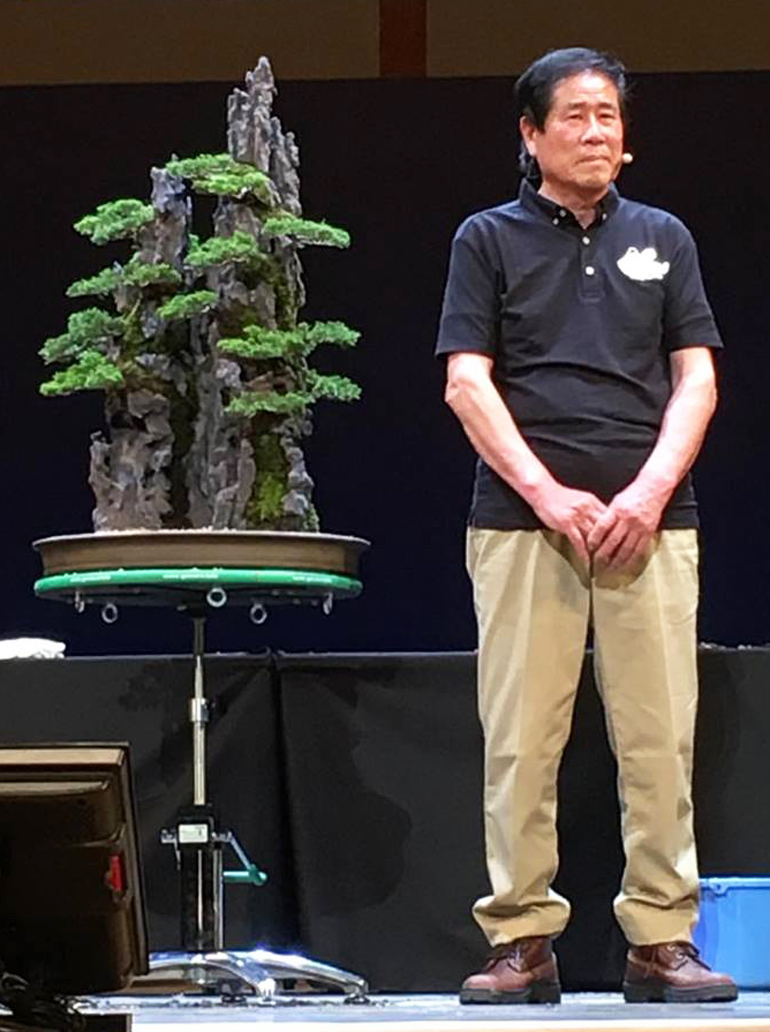
The Magician with one of his famous rock plantings and another omnipresent Green T at this summer's World Bonsai Convention
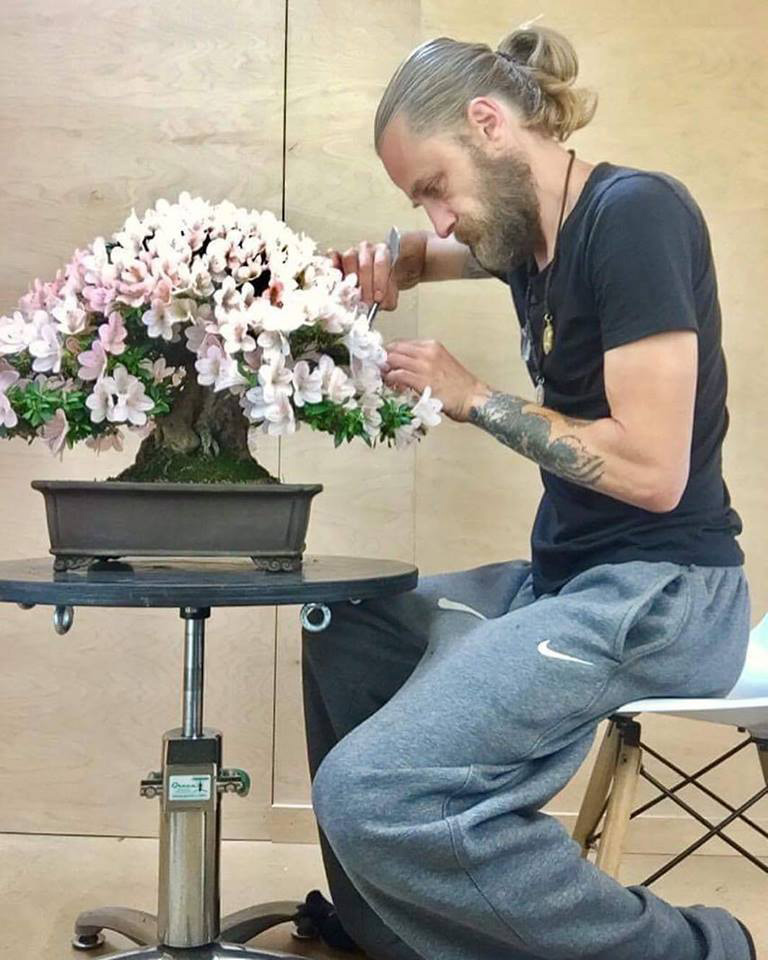
Here's the uncropped version of the photo from above. The artist is Marcin Gajewski
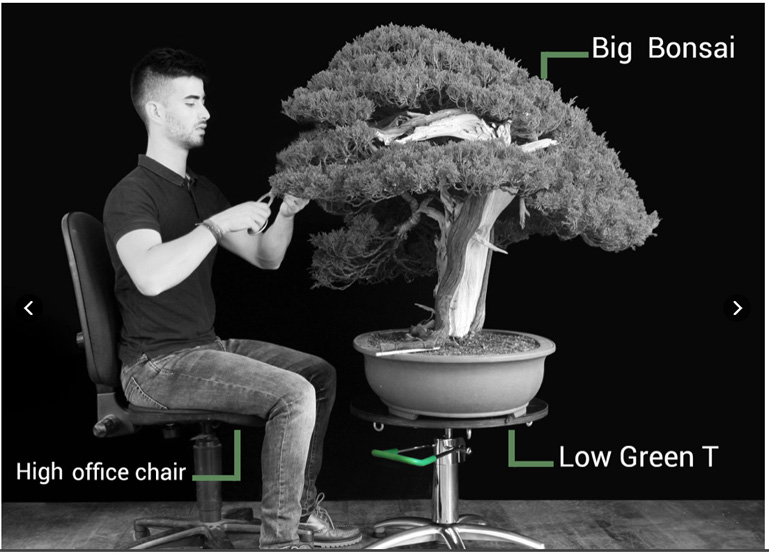
One example of why the Green T Basic is the turntable for large bonsai
The Tallest Trees in the World Brought Down to Bonsai Size
Closeup of a California Coast redwood from Bonsai Mirai's collection. It's interesting that most Redwood bonsai tend to be so stocky, given that that they are the tallest trees in the world. You can see the photo of the whole tree below
Continuing from yesterday with Bonsai Mirai,the home of what must be the largest and most impressive collection of collected bonsai (yamadori) in the country. Today it’s California’s Coast redwoods (Sequoia sempervirens)
There are so many iconic North American trees. In fact, and at the risk of just a little chauvinism, our rich array of trees just might be the most impressive in the world
Continued below…
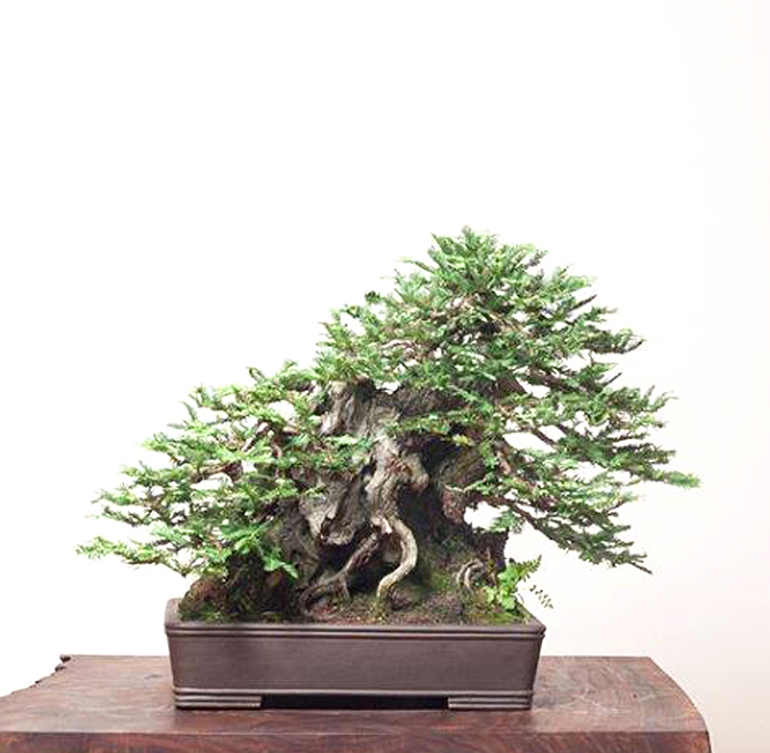
This one and the others shown here are all Coast redwoods
Continued from above
Especially the ones you find from the Rockies out to the Pacific ocean. You could start with the tallest trees in the world (Coast redwood – Sequoia sempervirens) and move to the largest trees in the world (Giant sequoias – Sequoiadendron giganteum) and then, staying on the West coast, through several others that are among the tallest, largest and most magnificent anywhere.
Fortunately, many of these monsters lend themselves to bonsai. Not the least of which is today’s Coast redwood.
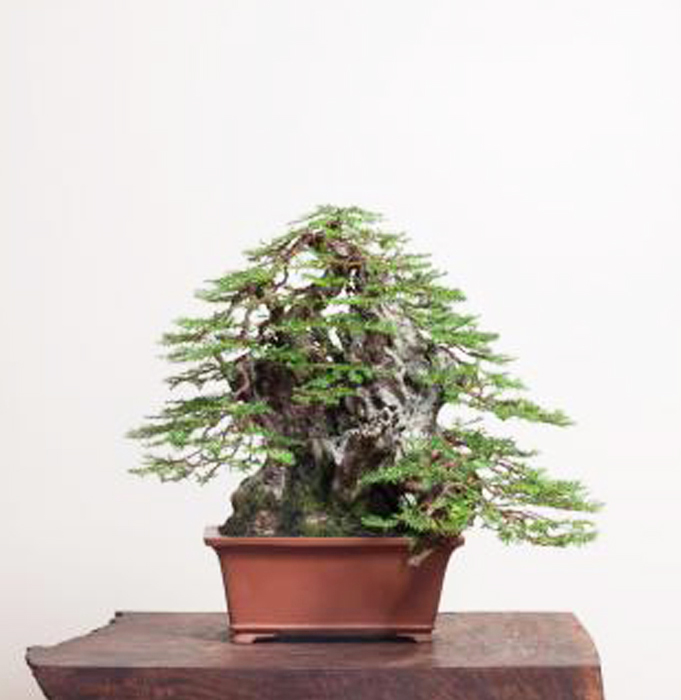
A quote from Bonsai Mirai’s website… “Bonsai Mirai creates trees that connect people to their culture, natural surroundings, and to the spirit of the individual. Led by bonsai professional Ryan Neil and his collaborators from around the world, Bonsai Mirai is pioneering the movement to create bonsai reflective of the vast array of American landscapes.”

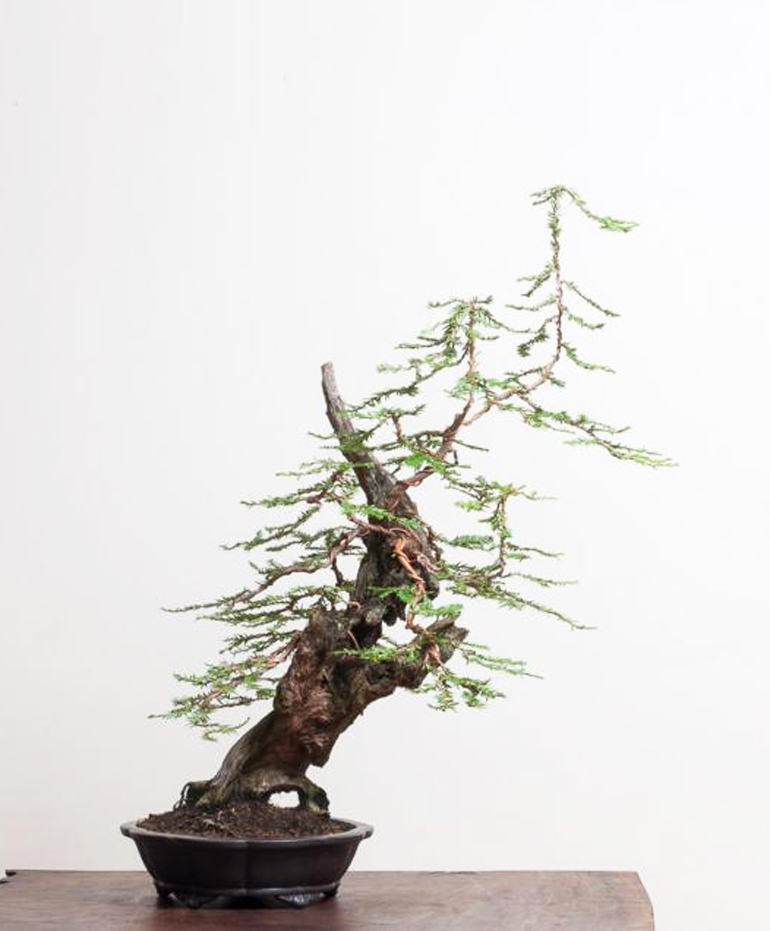
This one is rangier. Perhaps a little more like what you might expect from the world's tallest tree
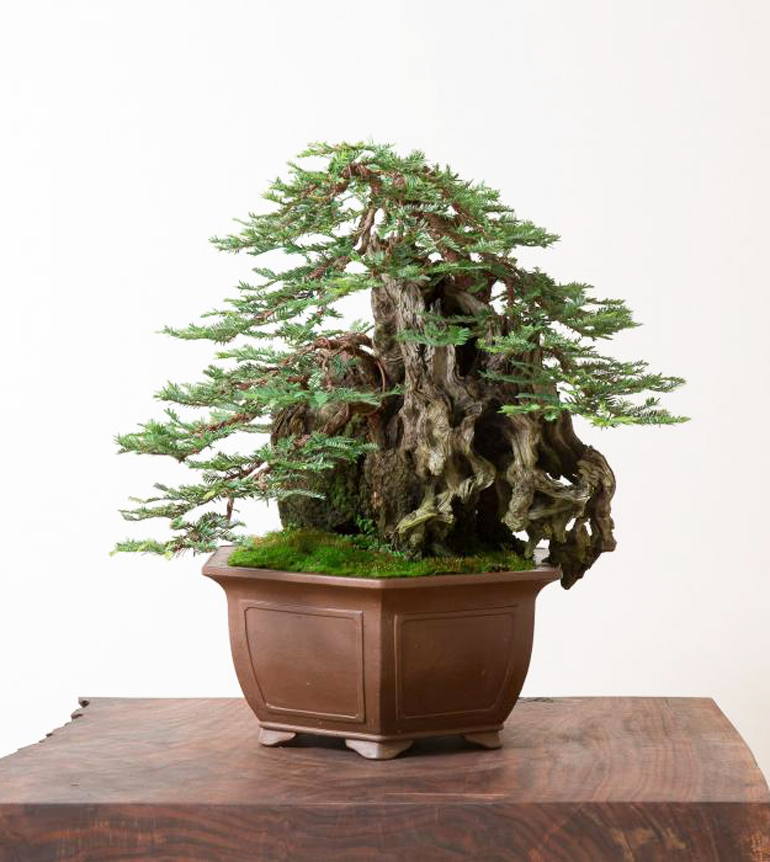
The original photo of the tree at the top of the post
Cross Country Bonsai Wagon
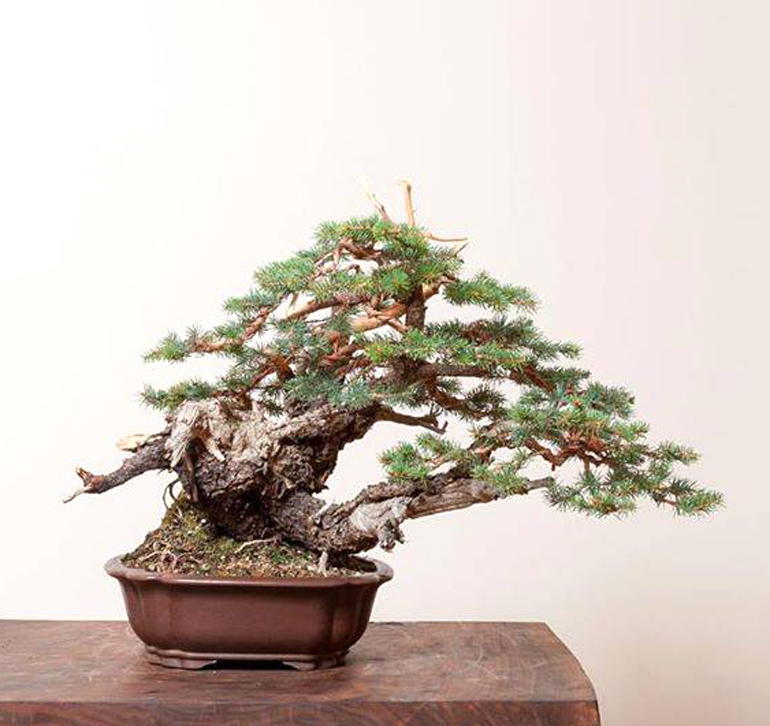
One of several bonsai recently posted by Bonsai Mirai. No varieties were given for any of the trees shown here (on social media*), but we do know that they belong to Ryan Neil. If you'd like to know more about these trees and you have time, you can sort through the Mirai website. Even if you don't find all the ones shown here, you'll see many of the very best American yamadori (collected from the wild) trees. *Bonsai Mirai's fb timeline
Just in case you forgot, this post can serve as another reminder about the rapidly approaching 6th U.S. National Bonsai Exhibition. It’s the one bonsai event not to miss, and it only happens once every two years. Your destination is Rochester, NY, and your dates are September 8th and 9th. If you haven’t already made your plans, there’s no time like now.
Continued below…
The cross country covered wagon full of bonsai is coming soon. Here's a quote from Bonsai Mirai... "Need trees shipped for the National Show? In the first week of September, the wagon will ride from Portland, OR to Rochester, NY, stopping en route to drop off* goods. Our professionally driven transport system is the safest and most sure way of getting your trees, pots, stands, and soil from point A to B. Please inquire to reserve your spot."
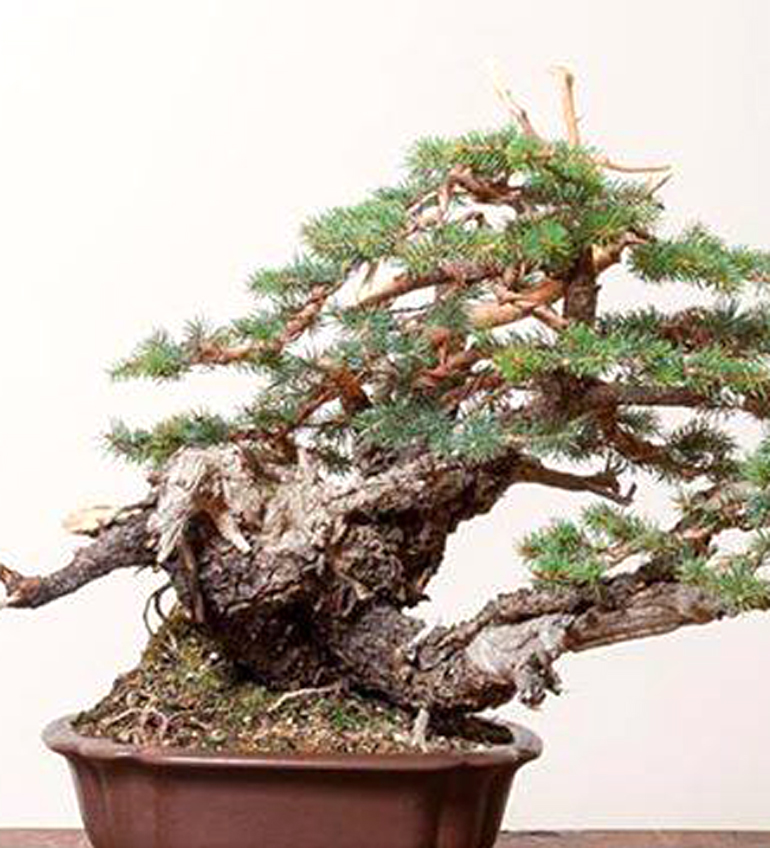
Just in case you want a closer look at the tree above (please pardon the fuzz, it's all my doing)
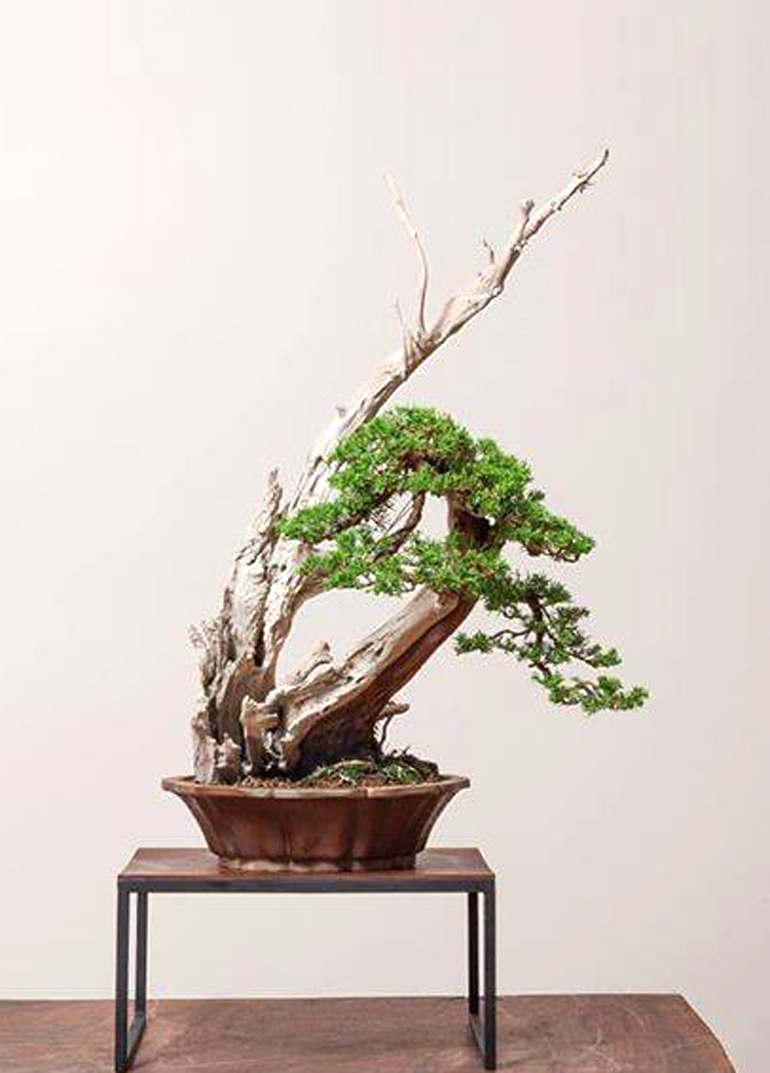
Another Mirai mystery tree that was posted on fb
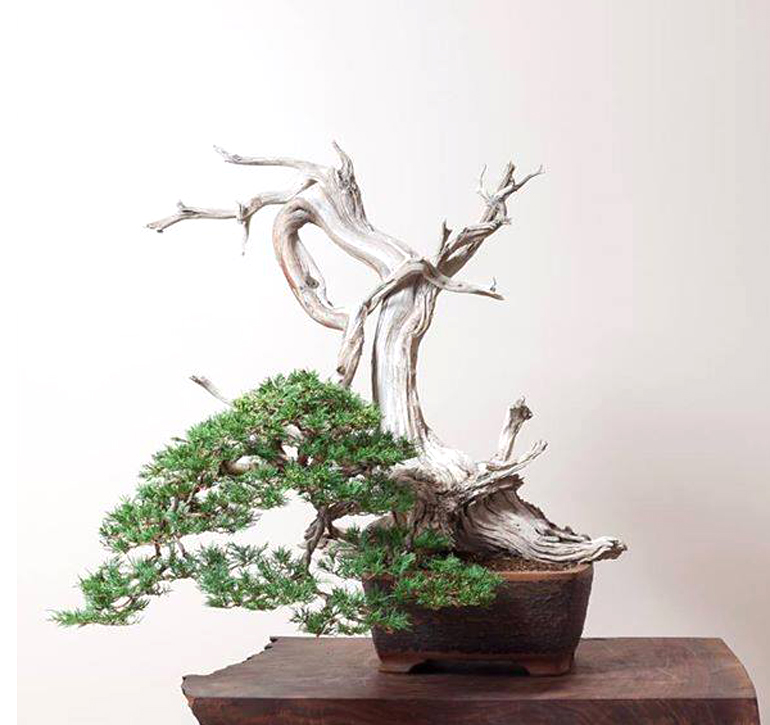
And another
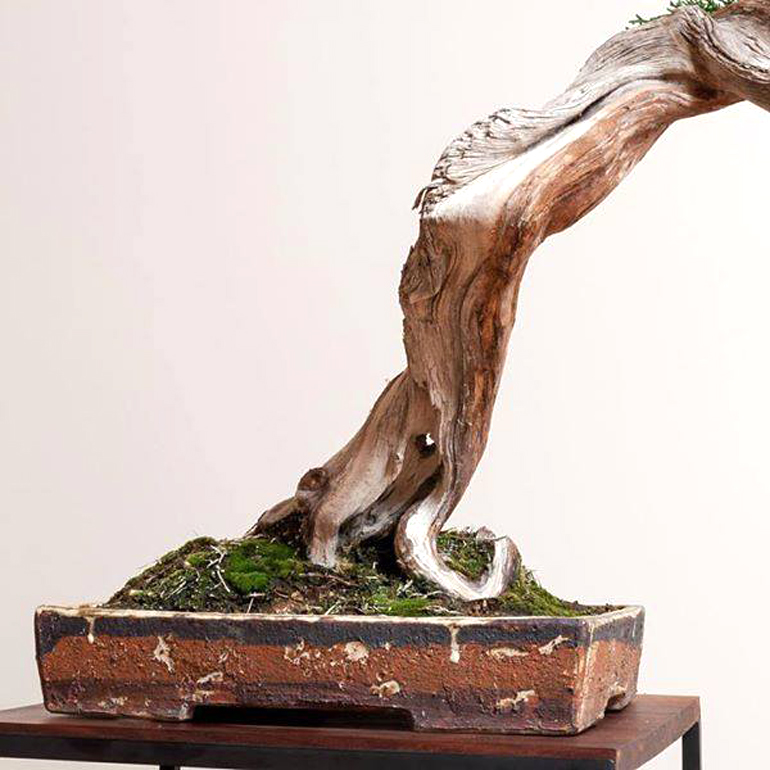
One more.... a great funky old pot!
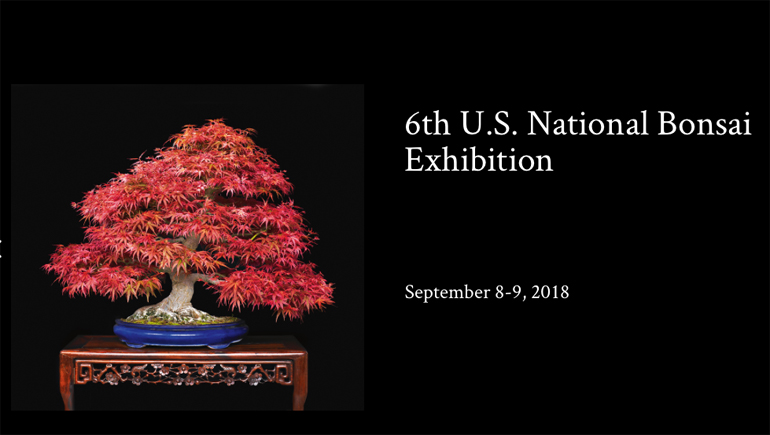
Bonsai at the Intersection of Environmental Art, Durational Art, Performance, Architecture, and Design
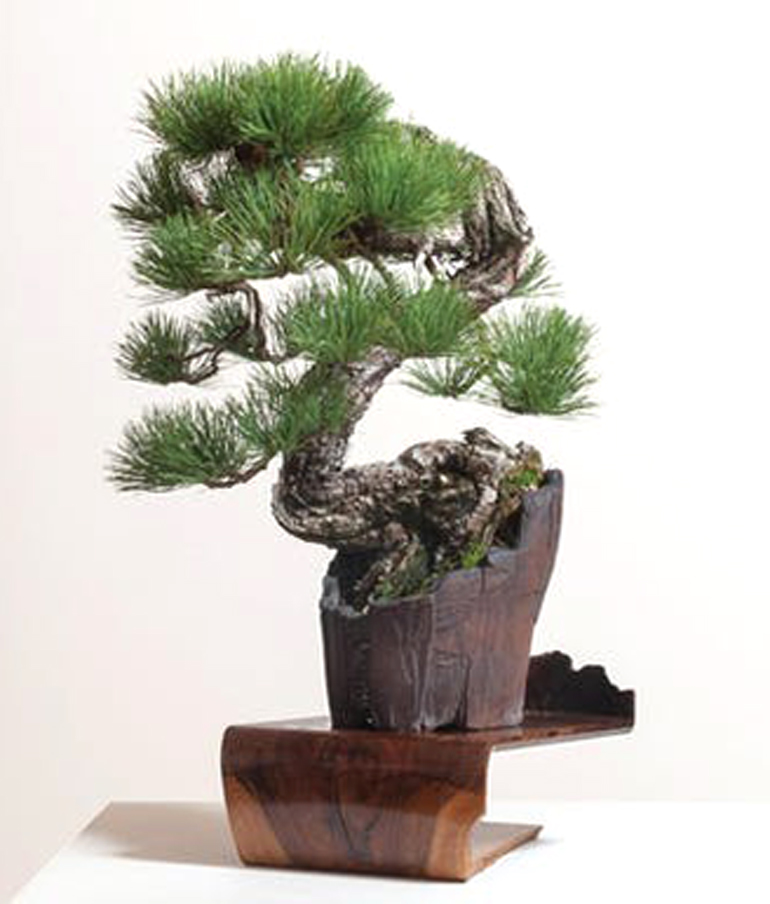
There's more than the tree to bonsai. This photo with the brilliantly conceived pot and stand - and the way they both emphasize and elevate (literally) the tree - perfectly illustrates this point. It's from a special event flyer posted by Pacific Bonsai Museum titled LAB, Living Art of Bonsai. The date is August 4th. The rest of the details are here
This event looks and sounds so compelling that if it weren’t for previous unbreakable commitments, I’d be making my reservations right now. But perhaps you can be lucky!
Here’s part of the copy from the Pacific Bonsai Museum about the upcoming LAB…
“In a Frank Lloyd Wright-designed home on the outskirts of Seattle, Pacific Bonsai Museum presents the exclusive first performance of the LAB (Living Art of Bonsai): an experimental collaborative pushing the limits of bonsai design. Guests explore the intersection of environmental art, durational art, performance, architecture, and design, as they witness the creation of a living sculpture and watch as three renowned artists–Ryan Neil (bonsai artist), Ron Lang (ceramicist) and Austin Heitzman (furniture maker)–resequence traditional bonsai practices under the influence of a work of an iconic American architect….” The rest of the copy and essential event details (including the date, August 4th) are here
Here's the original photo from the Museum
This is not the first time the Pacific Bonsai Museum
has conceived and executed such ground breaking events…
This photo presents a piece of a Mountain hemlock planting by Michael Hagedorn's with a painting of Mt Rainer. It was part of the Pacific Bonsai Museum’s Strikingly Beautiful Mix of Bonsai & Paintings that took place last year
Bonsai Pioneer Mas Ishii & Michael Bonsai
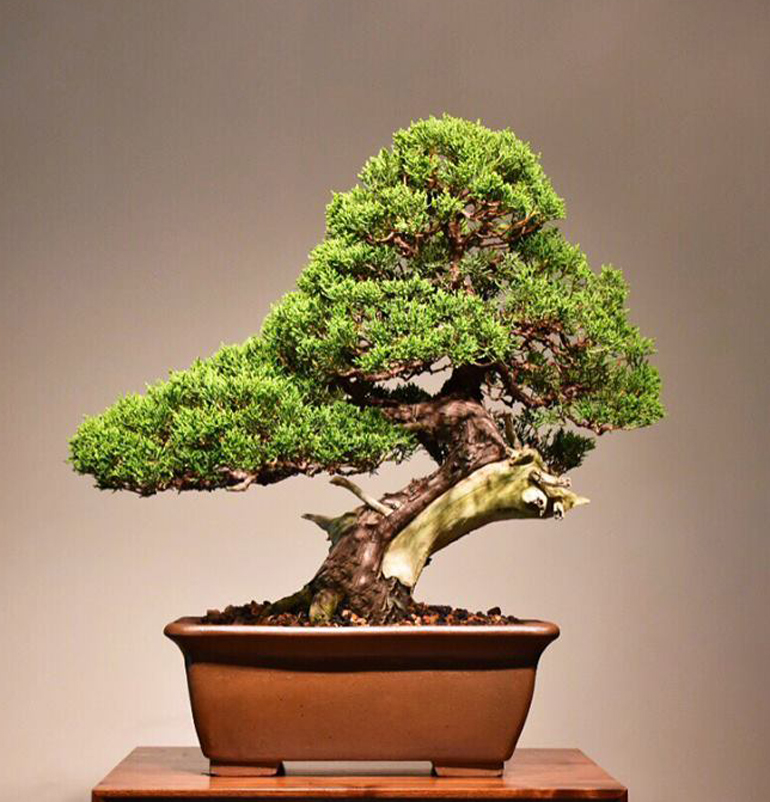
Here's Michael's (Michael Bonsai) caption for this tree... "I was “craving” to style my 80 year old Masaru-Ishii grafted juniper. I’ve never been really happy how it was prior styled. - This is the first time I really like the outcome, because I styled it myself and was motived after a long stretch of engineering and work and not being able to do “hands on” bonsai." I cropped Michael's photo (see below) for a closer look
I’ve long appreciated the quality of Michael Bonsai’s photos. And his trees. This one originated with Mr Masaru Ishii (now deceased), grafting master (especially on Shimpaku junipers) and one of the pioneers of American bonsai. Mr Ishii’s son Gary, is now running Chikugo-en. the Ishii family bonsai nursery. A stop worth making if you’re in the L.A. area.
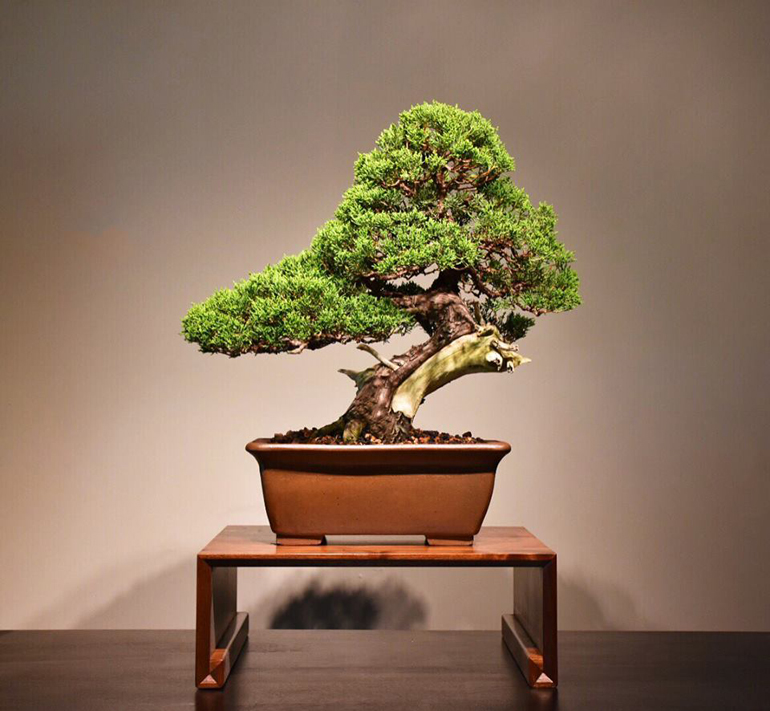
Michael's original photo. More room to breath
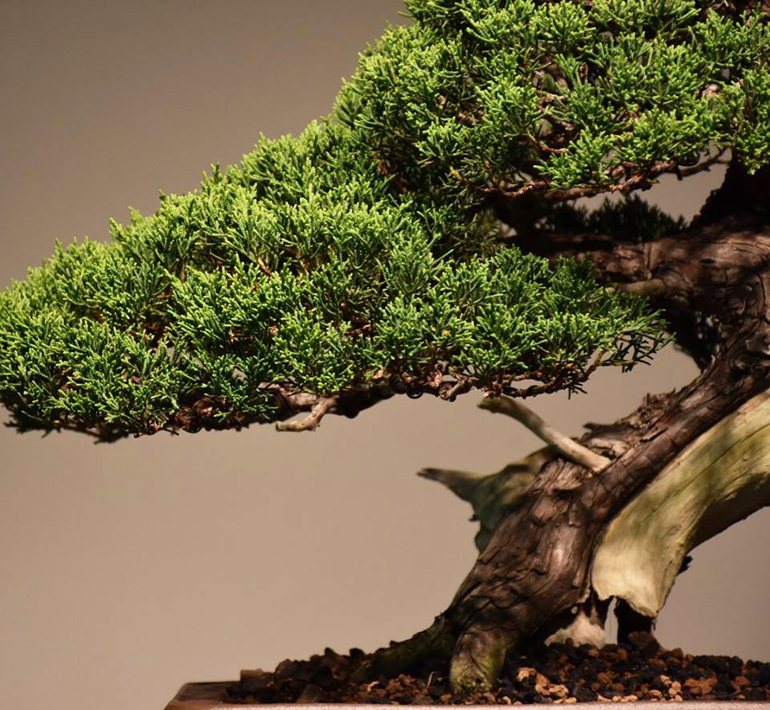
Close up by Michael
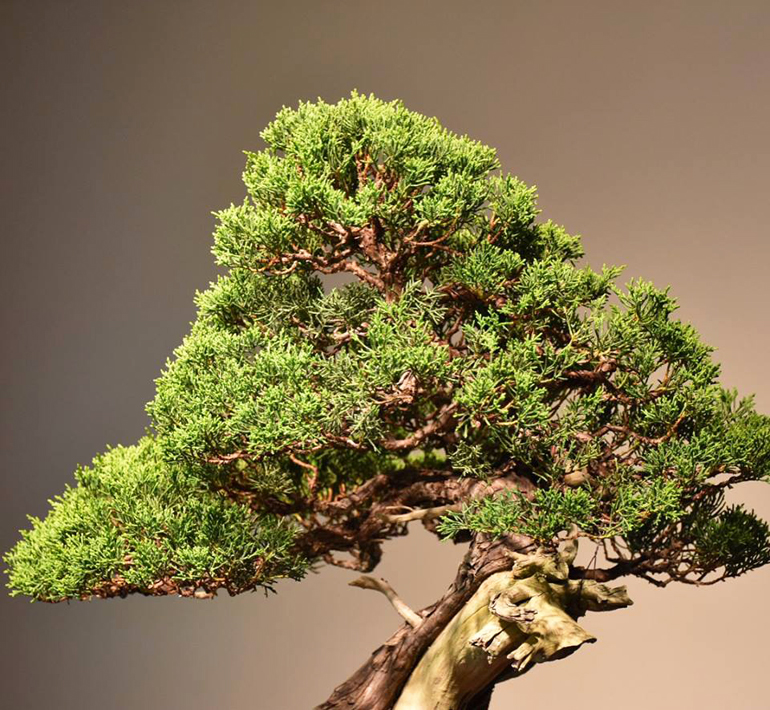
Another of Michael's closeups

One more...
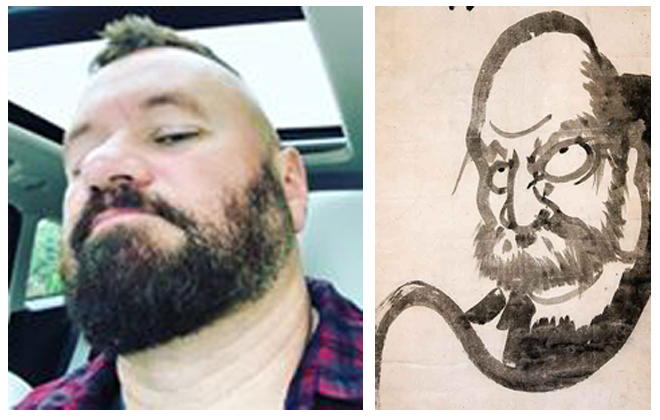
Michael's facebook photo and a painting of Bodhidharma, a famous monk who lived in 5th or 6th century China
Heavenly Bonsai, an Old Larch, a Tree that Never Gave Up & a Terrific Subtext

American Larch (Larix laricina - aka Tamarack) by Larch Master Nick Lenz (from our archives). This brings us to the 6th U.S. National Bonsai Exhibition (September, 8th and 9th in Rochester). We will bring some field grown larches of our own. Nothing like this masterpiece. Just some rough stock, mostly 15 to 25 year old that originally came from a friend's land. We have been digging some every year and growing them on here at my place, for the last 14 years or so. We've been pruning for taper, so we've got some pretty good trunks. We'll try to have some decent photos soon
Sometimes I think I’m getting dull (duller?) I’ve been doing this for almost ten years and I’ve barely changed the format. My comments haven’t evolved all that much either. I’ve become a little more selective in what I chose to post, so that’s something. And the images are larger too, which also counts for something. But that’s about it. I’ve picked all the low hanging fruit, I’m not tall enough for any higher and I forgot where I put my ladder anyway
So, as I see it, it’s time to shake things up a bit and try something we haven’t done for a long time (if that doesn’t scare you, nothing will). A post without a single theme! (there is a subtext, but I haven’t figured out what it is)
You don't see that many Heavenly bamboo (Nandina domestica) bonsai (it's not a real bamboo). Though I understand why Miguel put his name on it, with so many people 'borrowing' photos and putting them up without attribution, still it is a little distracting
Nature's raft (. "It fell a long time ago, but it never gave up." (Keith Anderson's caption). This can only happen if some of the roots are still in the ground after the tree falls. Then gradually, roots start growing from the fallen trunk and the branches become new trunks and you've got a raft (Ikadabuki) style bonsai... or in this case, a full size natural raft
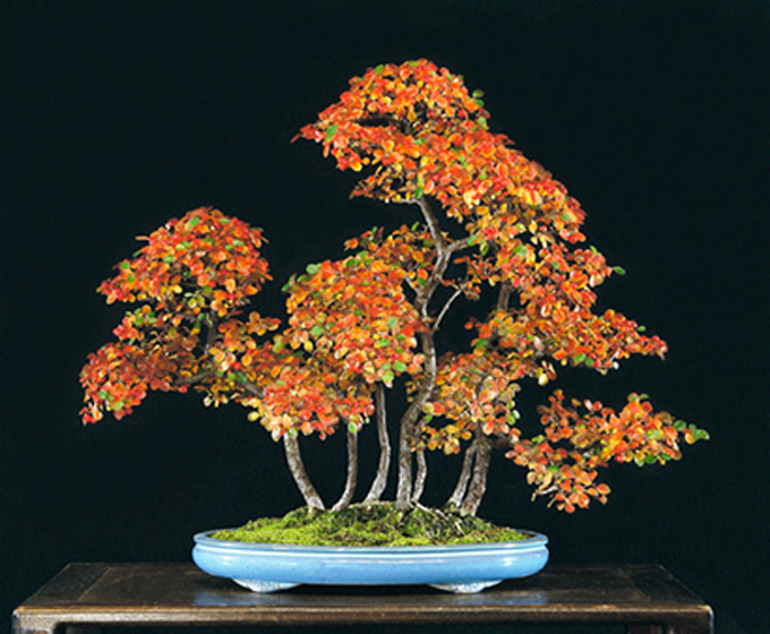
Here's a sinuous root raft bonsai where the original trunk is almost completely buried. It's a Rockspray Cotoneaster (Cotoneaster horizontalis) in splendid fall color, by Bill Valavanis of International Bonsai. Speaking of the 6th U.S. National Bonsai Exhibition (see above), Bill is the man
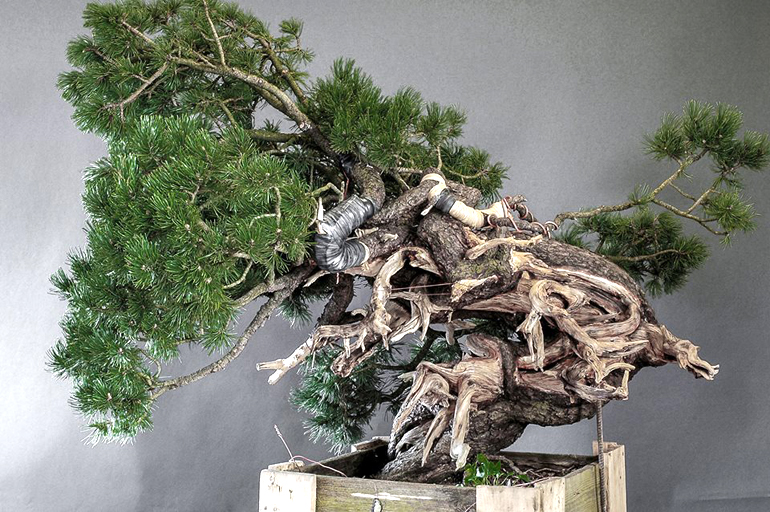
This wild child belongs to Sandro Segneri. Sando has a very long caption (poorly translated from Italian by a machine) that starts... "A tree before entering the shop must have spent a reasonable period of time to stabilize the force, develop growth..." (here's your link to the rest)
Backyard Bonsai 14 – “A Little Bit Above Average”
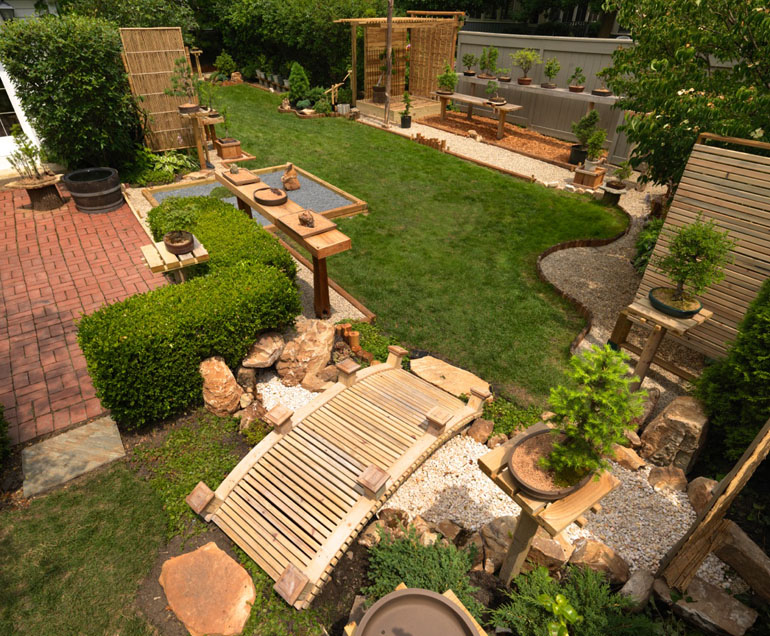
Bird's eye view of Dan Dolan's backyard.
It's Monday Monday and I've been at work since 7:00am, mostly answering emails and putting out small fires. Given that time is of essence, we'll get out our tools and dig back into our archival mine. This one, Dan Dolan's backyard, originally appeared in September, 2015. It fits well with our recently resurrected backyard theme
Dan Dolan sent along some of his thoughts on bonsai and bonsai display… “Unlike many enthusiasts who heed the remonstrance of American bonsai masters to acquire only the best material upon which to work…… I take only the least promising and strive to make them a little bit above average.”
Continued below…
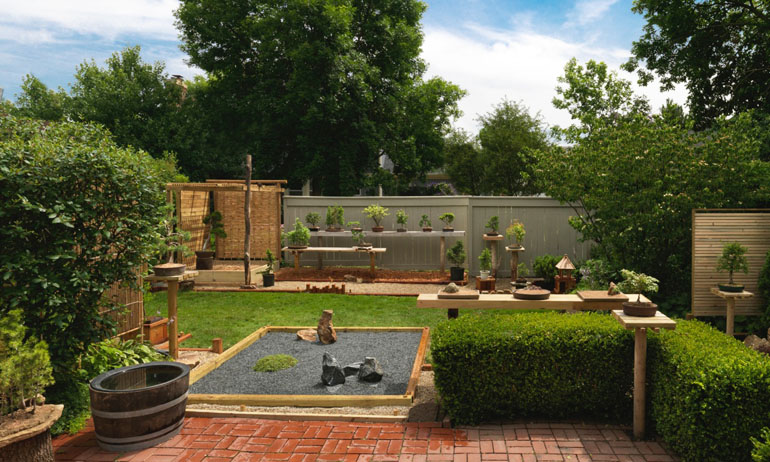
Dan, continued from above… “As a previous Board Member of the Midwest Bonsai Society at the Chicago Botanic Garden, I spoke often on the subject of bonsai display. My theme was to encourage our members to invest at least as much on the environment in which they grow, develop, refine and present their trees in training (99% of our trees are in training, as Walter Pall acknowledges) as they do on the material, containers, tools and supplies.”
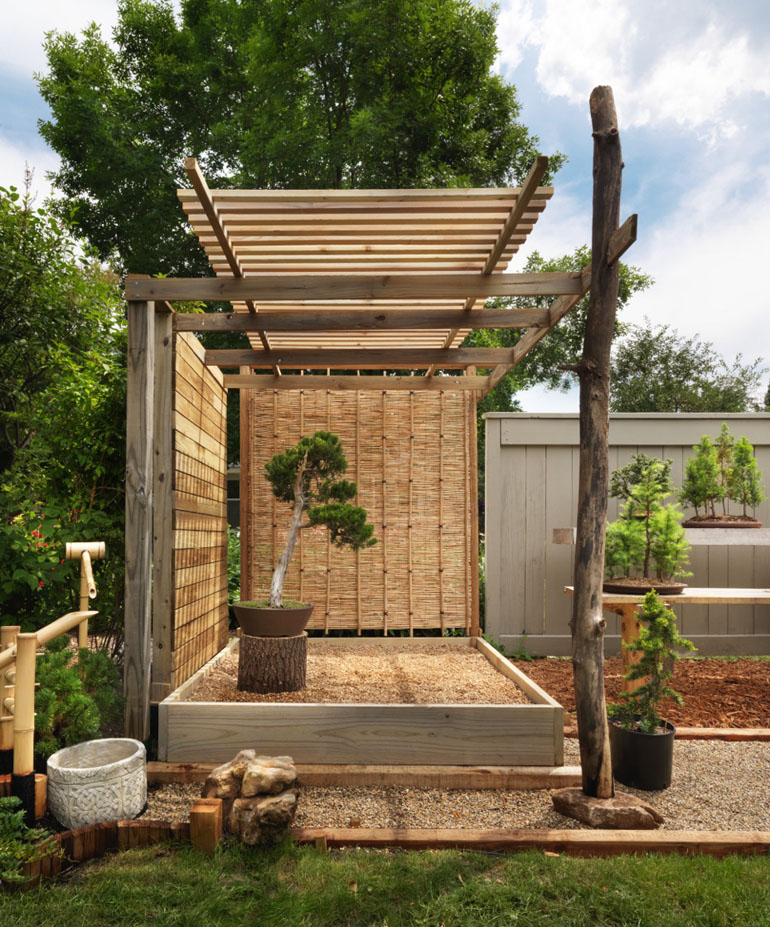
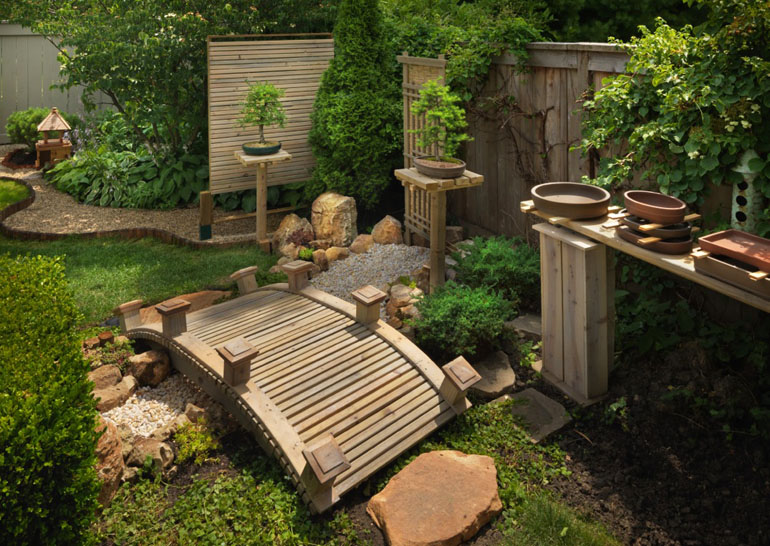
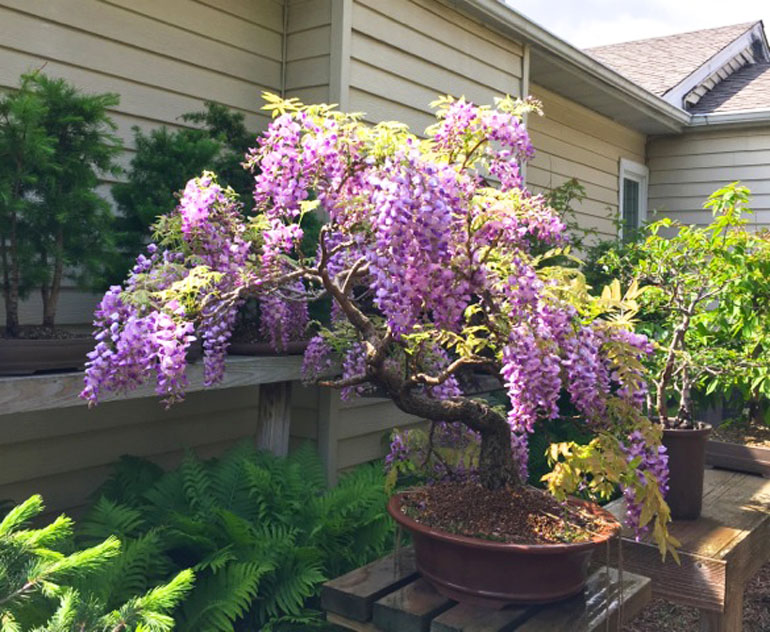
Japanese wisteria (Wisteria floribunda) showing off.
Dan's Bonsai Today library
Bonsai Folk Art
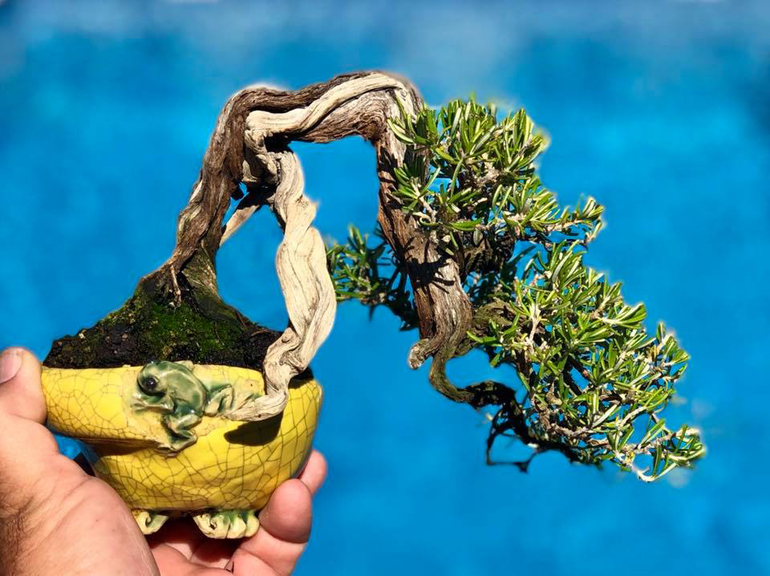
Bonsai folk art. There's so much that's unusual and delightful about this one, that I won't bother to say much, except that the tree looks like anOlive(talk about asleep at the wheel, and thanks to a couple astute readers, we're going have to revise this to Rosemary), I love it and Juan Antonio's caption says... "Otro listo. Romero Palaui." I don't know who Romero Palaui is, but his name comes up on Pinterest a lot. The World Cup Finals start in about 80 minutes, so we'll save researching him for another time

Closeup of the pot and deadwood.Frog too

No caption with this one, so your guess is as good as mine

Closeup. Interesting pattern

